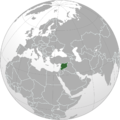Knowledge fuels change
For over a decade, Energypedia has shared free, reliable energy expertise with the world.
We’re now facing a serious funding gap.
Help keep this platform alive — your donation, big or small, truly matters!
Thank you for your support
Difference between revisions of "Syria Energy Situation"
***** (***** | *****) m |
***** (***** | *****) |
||
| (4 intermediate revisions by 2 users not shown) | |||
| Line 1: | Line 1: | ||
| + | |||
{{CES Country | {{CES Country | ||
|CES Country Name=Syria | |CES Country Name=Syria | ||
|CES Country Capital=Damascus | |CES Country Capital=Damascus | ||
| − | |CES Country Region=Middle East & North Africa | + | |CES Country Region Middle East and North Africa = Middle East & North Africa |
|CES Country Coordinates=33.5000° N, 36.3000° E | |CES Country Coordinates=33.5000° N, 36.3000° E | ||
}} | }} | ||
| + | <br/> | ||
| + | |||
| + | = Introduction = | ||
| + | |||
| + | <font face="Times New Roman, serif"><font style="font-size: 12pt" size="3"><font face="Calibri, serif">In</font><font face="Calibri, serif"><span lang="en-US">2011, before the war, the electrification level in Syria was 96,3 %</span></font><font color="#ff0000"><sup><font face="Calibri, serif"><span lang="en-US"></span></font></sup></font><font face="Calibri, serif"><span lang="en-US">which means that the electrical service had reached almost to all population except some Bedouin in the eastern part of Syria.</span></font> Electrical sector is a state-owned monopoly.'''Ministry of Electricity '''is responsible <font face="Calibri, serif"><span lang="en-US">for the electricity production, transmission, and distribution all over Syria.</span></font></font></font> | ||
| + | <br/> | ||
| − | = | + | = Energy Situation = |
| + | |||
| + | = Renewable Energy = | ||
| − | = | + | = Fossil Fuels = |
= Key Problems of the Energy Sector = | = Key Problems of the Energy Sector = | ||
| Line 16: | Line 25: | ||
= Policy Framework, Laws and Regulations = | = Policy Framework, Laws and Regulations = | ||
| − | == | + | = Institutional Set up in the Energy Sector = |
| + | |||
| + | = <span style="background-color: rgb(255, 255, 255);">Other Key Actors / Activities of Donors, Implementing Agencies, Civil Society Organisations</span><br/> = | ||
| − | = | + | = Further Information = |
= References = | = References = | ||
| Line 24: | Line 35: | ||
<references /> | <references /> | ||
| − | |||
[[Category:MENA_(Middle_East_and_North_Africa)]] | [[Category:MENA_(Middle_East_and_North_Africa)]] | ||
| − | |||
[[Category:Syria]] | [[Category:Syria]] | ||
Latest revision as of 07:25, 18 September 2018
Capital:
Damascus
Region:
Coordinates:
33.5000° N, 36.3000° E
Total Area (km²): It includes a country's total area, including areas under inland bodies of water and some coastal waterways.
XML error: Mismatched tag at line 6.
Population: It is based on the de facto definition of population, which counts all residents regardless of legal status or citizenship--except for refugees not permanently settled in the country of asylum, who are generally considered part of the population of their country of origin.
XML error: Mismatched tag at line 6. ()
Rural Population (% of total population): It refers to people living in rural areas as defined by national statistical offices. It is calculated as the difference between total population and urban population.
XML error: Mismatched tag at line 6. ()
GDP (current US$): It is the sum of gross value added by all resident producers in the economy plus any product taxes and minus any subsidies not included in the value of the products. It is calculated without making deductions for depreciation of fabricated assets or for depletion and degradation of natural resources.
XML error: Mismatched tag at line 6.2 ()
GDP Per Capita (current US$): It is gross domestic product divided by midyear population
XML error: Mismatched tag at line 6. ()
Access to Electricity (% of population): It is the percentage of population with access to electricity.
XML error: Mismatched tag at line 6.no data
Energy Imports Net (% of energy use): It is estimated as energy use less production, both measured in oil equivalents. A negative value indicates that the country is a net exporter. Energy use refers to use of primary energy before transformation to other end-use fuels, which is equal to indigenous production plus imports and stock changes, minus exports and fuels supplied to ships and aircraft engaged in international transport.
XML error: Mismatched tag at line 6.no data
Fossil Fuel Energy Consumption (% of total): It comprises coal, oil, petroleum, and natural gas products.
XML error: Mismatched tag at line 6.no data
Introduction
In2011, before the war, the electrification level in Syria was 96,3 %which means that the electrical service had reached almost to all population except some Bedouin in the eastern part of Syria. Electrical sector is a state-owned monopoly.Ministry of Electricity is responsible for the electricity production, transmission, and distribution all over Syria.





















